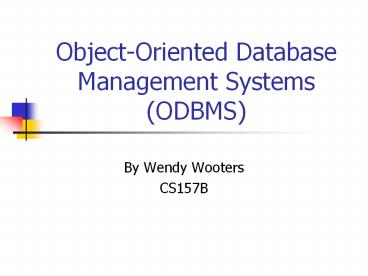Object-Oriented Database Management Systems (ODBMS) - PowerPoint PPT Presentation
1 / 15
Title:
Object-Oriented Database Management Systems (ODBMS)
Description:
Title: Data Mining and Data Warehousing Author: Owner Last modified by: Owner Created Date: 11/18/2004 3:31:18 PM Document presentation format: On-screen Show – PowerPoint PPT presentation
Number of Views:497
Avg rating:3.0/5.0
Title: Object-Oriented Database Management Systems (ODBMS)
1
Object-Oriented Database Management Systems
(ODBMS)
- By Wendy Wooters
- CS157B
2
ODBMS Outline
- Definition
- Why
- Who
- Approaches
- Persistent Programming Languages
- Object-Oriented Concepts
- Object
- Class Encapsulation
- Inheritance Polymorphism
- Object Identifier (OID)
- Advantages and Disadvantages
- Example Code
- Conclusion
3
What is an ODBMS?
- Database that stores data elements as objects.
Uses object-oriented concepts. - Object - like an entity in and E-R Diagram.
4
Why use ODBMS?
Product DB
- Complex data or relationship requirements
- Lack of unique, natural identification
- Large numbers of many to many relationships
- Access using traversals. Graph/Tree structure.
- Frequent use of type codes such as those found in
the relational schema
Source http//www.service-architecture.com/object
-oriented-databases
5
Who Uses ODBMS?
- Typical Applications for ODBMS
- Computer-aided design (CAD)
- Computer-aided software engineering (CASE)
- Multimedia databases
- Images, video, games, etc.
- Office automation systems (OIS)
- Expert database systems
6
Approaches for ODBMS
- Relational DB extended to use object-oriented
concepts. (Object-relational DB) - DB is Relational
- Programming language is object-oriented.
- Object-oriented DB model.
- Application and database use same object-oriented
model. - Uses persistent programming languages.
7
Persistence Programming Languages
- A programming language that directly manipulates
persistent data in a database. - Persistent data exists after the program
terminates. - Single program for application and data
management. No translation from database to
application programming needed. - Used with the object-oriented DB model approach.
8
Object-Oriented Concepts Object
- Object is an entity containing
- Variables/Attributes Object Data
- Relationships References to other objects
- Methods Object Functions
- Messages Accessing Methods
9
Object-Oriented Concepts Class Encapsulation
- Public class Employee
- //Class Attributes
- private int SSN
- private String name
- private Date hired
- private double salary
- //Class Constructor
- public Employee()
- //Class Accessor Methods
- public int getSSN()
- public String getName()
- public Date getHired()
- public double getSalary()
- //Class Mutator Methods
- public void setName(String newName)
- public void setHired(Date newHired)
- Class encapsulates the data structure and
operations of the object. - Internals are hidden from the user.
- User only knows available methods and how to call
them.
10
Object-Oriented Concepts Inheritance
Polymorphism
- Inheritance - A class (subclass) can inherit the
characteristic of another class (superclass). - Example Employee has inherited attributes and
methods from Person. - Polymorphism - Each subclass object can respond
differently to same message by overriding the
superclass method. Example
11
Object-Oriented Concepts Object Identifier
- Object Identifier (OID) The unique OID is
maintained by the DBMS. - ODBMS - Generated automatically by the system.
Example Reference to Date object in the Employee
object for the date hired. - RDBMS Primary key. Example SSN for Employee
12
ODBMS Advantages
- Matches the object-oriented application design
- Reduces code, execution time and paging
- Real world data model
- Easier Navigation
- Allows reusability of objects generic objects
can be used in many applications. - Manages Complex data types more efficiently.
- Supports distributions of data across networks
more efficiently.
13
ODBMS Disadvantages
- Still developing
- Lack of accepted standards
- Lack of development tools.
- Change is more likely to occur in model
- More complicated than the relational model.
Takes longer to learn. - Not as efficient when data and relations are
simple.
14
Java ODB Example
- import org.odmg.
- import java.util.Collection
- Implementation impl new com.vendor.odmg.Implemen
tation() - Database db impl.newDatabase()
- Transaction txn impl.newTransaction()
- try
- db.open("addressDB", Database.OPEN_READ_WRITE)
- txn.begin()
- // perform query
- OQLQuery query new OQLQuery(
- "select x from Person x where x.name
\S. M. Lee\"") - Collection result (Collection)
query.execute() - Iterator iter result.iterator()
- // iterate over the results
- while ( iter.hasNext() )
- Example of how to access data in an ODB, using
the ODMG Object Query Language (OQL) - Opens DB
- Starts a transaction
- Executes a query to find a Person object named
S. M. Lee - Does additional processing on this Person object
- Gets Address object of Person
- Update street of Address object
- Commit transaction
- Close database
Source http//www.service-architecture.com/object
-oriented-databases
15
Conclusion
- Definition
- Persistent Programming Languages
- Object-Oriented Concepts
- Advantages and Disadvantages of ODBMS
- Example Code































